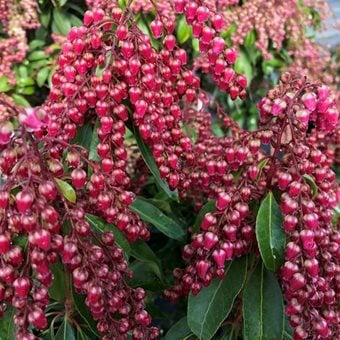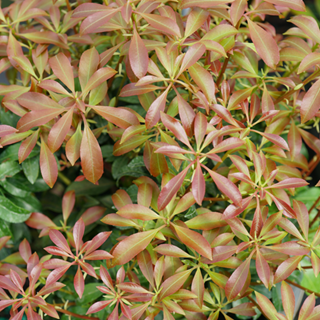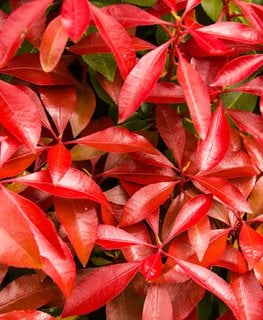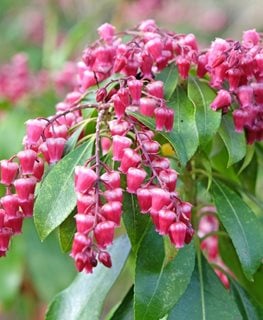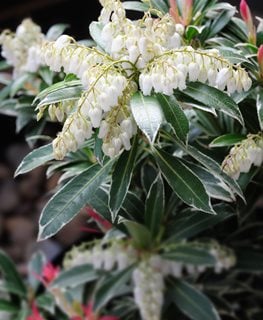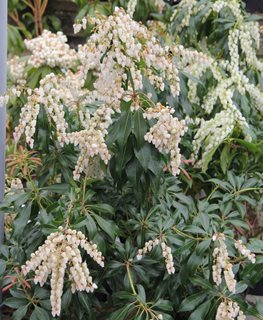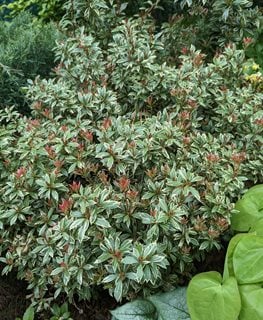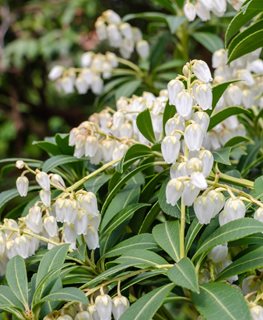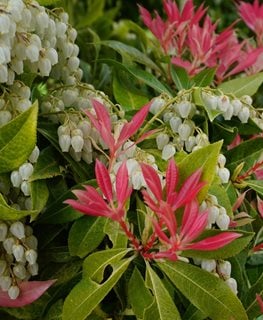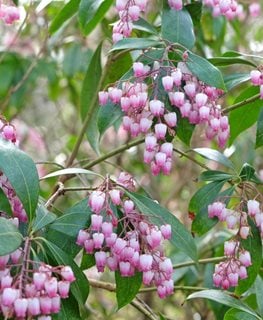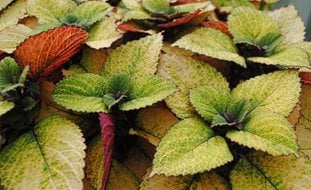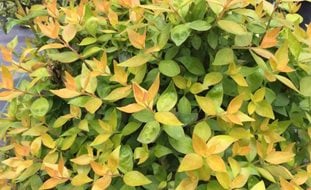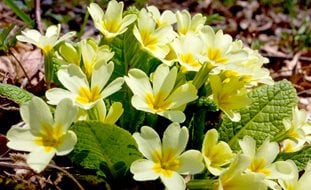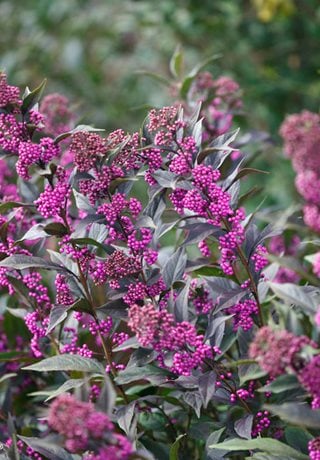Japanese Pieris: A Guide for Year-Round Beauty
Get planting and care tips for growing lily-of-the-valley shrub.Japanese pieris (also known as Japanese andromeda and lily-of-the-valley shrub) is one of those rare plants that captures your attention in all seasons. In early spring, it puts on a showstopping display of cascading bell-shaped flowers, similar in appearance to lily-of-the-valley.
At the same time the flowers open, new foliage emerges in vibrant shades of pink and reddish bronze, gradually deepening to a lustrous glossy green. During late summer and fall, colorful bead-like flower buds form and carry on through winter, providing dazzling contrast against the backdrop of evergreen foliage.
Slow growing and shade tolerant, lily-of-the-valley shrubs are ideal for adding year-round color to mixed borders, woodland gardens, and foundation plantings. Smaller dwarf varieties can also be planted in containers to provide multiseason interest on porches and patios.
On this page: Basics | Planting | Care | Varieties | Design Ideas
- BASICS
- HOW TO PLANT JAPANESE PIERIS
- JAPANESE PIERIS CARE
- JAPANESE PIERIS VARIETIES
- DESIGN IDEAS FOR USING JAPANESE PIERIS SHRUBS
BASICS
Botanical name:
Pieris japonica
Plant type:
Broadleaf evergreen shrub
Zones:
5-8 (some varieties are hardy in zone 4 if planted in a protected location)
Native area:
Native to Japan, Taiwan, and eastern China
Exposure:
Partial shade to full sun
Growth habit:
Upright and bushy
Height/spread:
3 to 12 feet tall and 3 to 8 feet wide, depending on the variety.
Bloom time:
Late winter (in mild climates) to early spring, with the blooms lasting up to two months.
Foliage:
Oblong, glossy green leaves are arranged in dense rosettes, with new growth often tinged with bright pink, red, or bronze. You can also find cultivars with variegated leaves.
Flowers:
Bell-shaped blooms dangle gracefully in clusters on long racemes. Colors range from pure white to pale pink to deep rose.
Special attributes:
- Deer resistant
- Cold tolerant
- Fragrant, nectar-rich flowers attract mason bees and other early-season pollinators
- Long-lived, with a lifespan of 40 years or longer under ideal conditions
Is Japanese pieris toxic?
Yes. All parts of the shrub, including the leaves and flowers, are highly toxic if ingested. Keep out of reach of children and pets.
PLANTING JAPANESE PIERIS
When to plant:
In warmer climates, planting can be done during the cooler months of early spring or fall. Colder climates should plant in spring.
Where to plant:
For the best flowering and foliage color, choose a site that receives full sun or dappled shade, providing at least 4 hours of sunlight daily. In southern regions, plants will benefit from some afternoon shade.
How to plant:
Loosen soil in the planting area and amend with compost or other organic matter. Dig a planting hole slightly wider and the same depth as the root ball. Place the plant in the hole so the crown is slightly higher than the surrounding soil and then backfill, tamping down the soil gently. Water the shrub deeply after planting and then weekly until it becomes established.
Soil:
Prefers rich, acidic, well-drained soil with a pH between 5 and 6. May suffer from chlorosis (yellowing of the foliage) if grown in alkaline soil. Learn how to test and adjust the pH of your soil.
Spacing:
Space plants 3 to 8 feet apart, depending on their width at maturity. To prevent fungal diseases, leave enough room between plants to allow for good air circulation.
Growing in containers:
If you live in an area with highly alkaline soil, growing lily-of-the-valley shrub in a container is a great alternative, as long as you choose a pot that’s large enough to accommodate the plant's root system. Use a high-quality potting mix (one designed for acid-loving plants is ideal), and make sure the container has adequate drainage holes. Get more tips for growing plants in containers.
JAPANESE PIERIS CARE
Watering:
Provide about an inch of water every week during the active growing season, aiming to keep the soil evenly moist but not waterlogged. Container-grown plants may need more frequent watering. Avoid overwatering; Pieris plants won’t tolerate standing water.
Amendments and fertilizer:
In spring, apply a fertilizer especially formulated for acid-loving plants, such as azaleas and rhododendrons, according to package instructions. Potted plants will need more frequent fertilization, generally once a month during the growing season.
Mulch:
To help suppress weeds and retain moisture, apply several inches of organic mulch to the shrub’s root zone, keeping mulch 4 inches from the woody stem. Pine needles are an excellent mulch for lily-of-the-valley shrubs because they add acidity to the soil as they break down.
Pruning and deadheading:
Often more attractive in their natural form, Japanese pieris shrubs require very little pruning, other than to maintain their shape and to remove dead or damaged branches. Because plants bloom on last year's wood, wait to prune until after the blooms fade in spring.
Although not necessary, deadheading the spent blooms can improve plant vigor by preventing seedpods from forming.
Propagation:
By seed or softwood cuttings taken after plants finish blooming in spring.
Overwintering:
Japanese pieris leaves and flower buds can suffer significant damage if exposed to harsh winter winds. If possible, plant your shrubs in a sheltered location protected from prevailing winds. Another option is to wrap a temporary wind block, such as burlap or old sheets, around your plants. To help prevent winter desiccation, keep your plants well-watered until the ground freezes in late fall.
Pests and diseases:
Especially susceptible to lace bugs, tiny insects that can cause foliar damage by sucking the juices from the plant’s leaves and peppering them with yellow and brown spots. Control by pruning off the affected foliage and spraying with insecticidal soap or neem oil. Fungal diseases, such as leaf spot, can also be a problem, especially if there is poor airflow between plants.
JAPANESE PIERIS VARIETIES
DESIGN IDEAS FOR USING JAPANESE PIERIS
- Japanese pieris is most attractive in plantings that are not crowded, displaying the shrub’s lovely silhouette and foliage. Its graceful contours become even more beautiful as the plant matures.
- Use as a striking backdrop in a foliage garden, recommends Rebecca Sweet, from Harmony in the Garden. Watch this video to see how she incorporates Japanese pieris into her own garden: Foliage Garden Plant Combos.
- Plant alongside rhododendrons, azaleas, camellias, and other broadleaf evergreens that thrive in well-draining acidic soil.
- Use as a background plant along with conifers in an Asian-themed garden.
- Underplant with spring-blooming bulbs, such as crocus, daffodil, and grape hyacinth, for an early season burst of color.
